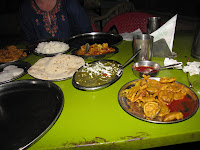Cilantro chutney (a mixture of cilantro, lime, garlic, ginger, salt and spices used for dipping and adding flavor) also seems to be a foreign substance in these parts, which surprises me. But perhaps it has something to do with the way in which I butcher the pronunciation of “hara daniya chutney”.
It is harder than I thought to be without access to a kitchen, and I had hoped that the “communal” living promised as part of this conference would include cooking together. It’s hard for me psychologically because cooking is a way in which I generate joy—for myself and others. It’s also hard physically because my health is rather dependent on access to fresh fruits and vegetables.
The food we have been eating borders on terrible, as I have mentioned elsewhere. For the most part it’s the tasteless remnants of vegetables (tomatoes, eggplant, peas, potatoes) that have been simmered in boatloads of oil, served with plain rice, dal (lentil soup) and wheat flatbreads called rotis (which, when fresh, are pretty amazing). But, um, fat and carbohydrate overload. We occasionally get a tiny little “salad” of fresh tomatoes, onions and chilis, served with poppadoms which I gobble up like a crazy person. But, this is not sustainable.


So, first stop, yesterday—mango stand. Mangos are in season and I have been endeavoring to eat them every day. Father Claude brings us some from his garden in the morning on occasion—sliced in half, with the pit removed. The flesh is so tender and sweet that you scoop it out of the skin with a spoon. Yes. Eating mangos out of season and in the United States is something I never do, so the unbelievable taste experience of eating one fresh and a few feet away from the tree was incomparable. We bought some local varieties at a stand yesterday—smaller and sweeter (if that is possible), with a pleasant citrus taste.
Next stop was a South Indian restaurant where Jen and I ordered dosa. Dosa is a South Indian dish of a thin pancake-like roll made of fermented rice and lentils, served with a tomato based broth and a ginger-mustard-coconut chutney. Yum. Not exactly fresh vegetables, but lighter and actually really really tasty. Finally! I think the local cooks see Westerners (although we are the only ones here) and knock down the spices a bit or something, because until yesterday I haven’t had a decently spiced dish yet. Maybe the cooking of India I am used to is just spicier (ha…my own!) or there are regional variations in spice. Spicy pickles are on the table at every meal, so perhaps this is how spice is customarily added.


Later in the day I had aloo gobi (potato and cauliflower curry) and palaak paneer (spinach and cheese curry) at another restaurant with veg pakora (fried vegetables). It was all delicious although the palaak paneer didn’t have enough spice. (What is up with this?)This is as good as it gets for eating vegetables so far.
Paanchmari is not what one would call a culinary hotspot. I equate it with the little town I grew up in that caters to holiday makers and tourists. Not great food, not bad food, but lots of it and for cheap.
In a few days we move on to Bhopal, where I am told the food is different. I hope that means better.

No comments:
Post a Comment